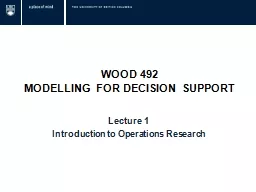

MODELLING FOR DECISION SUPPORT Lecture 1 Introduction to Operations Research What is this course about Understanding the principles of linear programming and its applications in forestry Understanding practical questions that managers have about forestry and forest products ID: 444767
Download Presentation The PPT/PDF document "WOOD 492" is the property of its rightful owner. Permission is granted to download and print the materials on this web site for personal, non-commercial use only, and to display it on your personal computer provided you do not modify the materials and that you retain all copyright notices contained in the materials. By downloading content from our website, you accept the terms of this agreement.
Slide1
WOOD 492 MODELLING FOR DECISION SUPPORT
Lecture 1
Introduction to Operations ResearchSlide2
What is this course about?Understanding the principles of linear programming and its applications in forestryUnderstanding practical questions that managers have about forestry and forest products
Translating the “forest system” to a mathematical model
Using the model to answer the questions
Sept 5, 2012
Wood 492 - Saba Vahid
2Slide3
What is the course format?Combination of lectures and labsExamples of mathematical models in class, posted on the course website
Weekly assignments in the computer lab: students develop or complete their own decision support models
Labs are posted each Thursday (starting next week) on the course website
Quizzes in class and two midterms
Course website:
http://courses.forestry.ubc.ca/wood492
Sept 5, 2012
Wood 492 - Saba Vahid
3Slide4
What is Operations Research (OR)?Involves “research” on “operations”Concerned with allocating resources and planning the operations of various components within an organization in the most effective way
Goes back many decades (WWII), started with military applications
Is used in : manufacturing, transportation, health care, military, financial services, natural resource management, etc.
Sept 5, 2012
Wood 492 - Saba Vahid
4Slide5
OR in forestryCutting pattern optimizationCut-block selection
Wood processing facility location
Road network design
Log bucking and merchandising at the stump
Production planning in wood processing facilities
Supply chain planning for forest companies
etc.
Sept 5, 2012
Wood 492 - Saba Vahid
5Slide6
Example: cutting pattern optimizationSept 5, 2012Wood 492 - Saba Vahid
6Slide7
Example: Road network designSept 5, 2012Wood 492 - Saba Vahid
7Slide8
Example: A forest company’s value chainSept 5, 2012Wood 492 - Saba Vahid
8
Forest
Bucking/merchandising
Transportation
Sawmill/Pulp mill
Transportation
Distribution centerSlide9
OR methods and techniques
Linear programming
Non-linear programming
Integer programming
Inventory theory
Dynamic programming
Queuing theory
Sept 5, 2012
Wood 492 - Saba Vahid
9
Game theory
Transportation problems
Network optimization
Simulation
Heuristics
…Slide10
OR modelling approachDefine the problem and gather dataFormulate a mathematical modelDevelop an algorithm to find solutions to the model
Test and verify the model
Analyze the results and make recommendations to eliminate the problem and improve the operations
Sept 5, 2012
Wood 492 - Saba Vahid
10Slide11
What is a mathematical model?quantitative representation of a system, showing the inter-relationships of its different componentsIs used to show the essence of a business/economic problemA mathematical model has 4 components:
A set of decision variables,
An objective function
A set of constraints
A set of parameters
Sept 5, 2012
Wood 492 - Saba Vahid
11Slide12
What is a mathematical model? – Cont’dDecision variables:the quantifiable decisions to be made (variables whose respective values should be determined) e.g.
x
1
, x
2, …
Objective function:
The identified measure of performance that is to be improved, expressed by using the decision variables
e.g.
2
x
1
+6.5x
2
, …
Constraints
:
Any restrictions to be applied to the values of decision variables
e.g.
x
1
>0, x
1
+x
2
<20, …
Parameters:
The constants in the equations, the right hand sides and the multipliers
e.g.
0,20, 6.5,…
Sept 5, 2012
Wood 492 - Saba Vahid
12Slide13
Example 1:
Custom Cabinets company
Use excess capacity for 2 new products: Pine desks & Alder hutches
Has three departments that are partially committed to producing existing products
Wants to determine how many units of each new product can be produced each week by using the excess capacity of departments to generate the highest profits
Sept 5, 2012
Wood 492 - Saba Vahid
13
Department
Capacity
per unit
Available capacity
per week
Pine desk
Alder hutch
Solid
wood
0.25
0
12
Panel
0
0.2
5
Finishing
0.25
0.5
18
Profit per unit
$40
$50
Objective
Decision variable
ConstraintsSlide14
Examples: decision variables and objectivesIn a road network design problem:Decision variables: which roads to build (binary variable)Objective: minimize the construction costsIn a land-use planning problem:
Decision variables: how many km
2
to assign to each purpose
Objective: maximize the total revenuesIn a cutting pattern selection problem:Decision variables: Which cutting pattern to use on incoming logs
Objective: maximize the profits or product volumes
Sept 5, 2012
Wood 492 - Saba Vahid
14Slide15
Solutions to the mathematical modelMany different algorithms for different types of models (linear, non-linear, integer, etc.)the “optimal” solution: the values of the decision variables for which the objective function reaches its best value, while all the constraints are satisfied“near optimal” solutions: when the optimal solution can not be mathematically calculated, but a close solution is found which satisfies all the constraints
Sensitivity analysis
: shows what would happen to the optimal solution if value of some variables or parameters are modified
Sept 5, 2012
Wood 492 - Saba Vahid
15Slide16
Importance of mathematical modelsHelp us better understand a systemTo determine best practicesTo study cause and effect relationships in the model
To ask “what-if” questions and answer them (you can’t try many different scenarios in real systems because it would be costly)
Sept 5, 2012
Wood 492 - Saba Vahid
16Slide17
Next ClassLearn about Linear programmingExample of LP formulationGraphical solution method for LP
Sept 5, 2012
Wood 492 - Saba Vahid
17